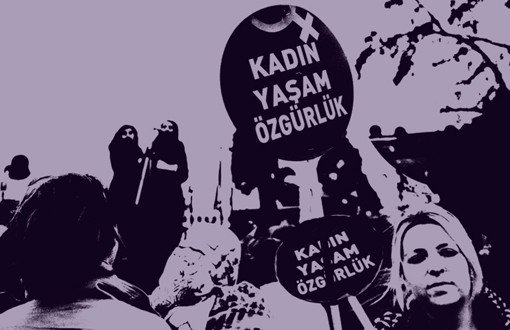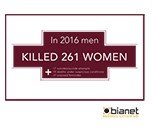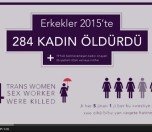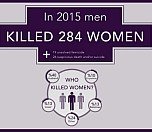Click here to read the article in Turkish / Haberin Türkçesi için buraya tıklayın
CLICK - VOICEOVER BY 3 MUSICIANS: WE MEN KILLED 284 WOMEN IN 2015
According to news bianet compiled from local and national newspapers, news websites, and agencies, men killed 284 women along with 19 children and 18 mean near them in 2015; raped at least 133 women and girls; injured / inflicted violence on 370 women; harassed at least 208 women and girls.
Men had killed 281 women in 2014, raped /attempted to rape 109 women and girls, injured 560 women, harassed 140 women and girls.
Homicide
Men killed at least 284 women along with 19 children and 18 mean near them in 2015.
We give coverage to categories of “unidentified murder”, “suspicious dead” as of 2014. Six of the perpetrators included in these categories have been identified. Thus, the number of women murdered rose to 284 from 278 as stated in December 2015 report.
At least four of the murdered women got forcefully married. Perpetrators of 19 women whom were determined to be murdered are yet to be found (or didn’t appear in media); 26 women were found suspiciously dead or claimed to have committed suicide.
54% of the women were murdered by their partners (lover, fiancée, husband), 10% by their ex-partners (ex-lover, ex-fiancée, ex-husband), 13% by their male relatives.
103 women were killed by their husband of civil marriage, 10 by their husband of religious marriage, 37 by their lovers, 20 by their ex-husbands, 13 by their fathers, nine by their elder/younger brothers, 14 by their relatives, 11 by their sons-in-law, one by her former son-in-law, four by men from her husband’s family, four their fiancées, six by their ex-lovers, six by their sons, nine by their friends or men they know, four by their lover of their mother or daughter, four by their friends’ ex-husbands or lovers, one by her husband’s son, one by someone whom she knew at the workplace, three by their customers, three by their neighbors, four by rapists, three by men whom they refused their relationship proposal, six by men breaking into their houses for theft, and one by a man whom she didn’t know. Acquaintance degree of five women were not reported in media.
56% of the women were killed by firearms, 29% by knife and sharp objects; 96 women were killed by pistol, 63 by rifle, 81 by knife and sharp objects, 19 by being choked, 10 by being sliced in throat, seven by being battered, five by being battered by an object, one by being set on fire, one by being run over by car.
19% of the women were murdered for seeking divorce, or turning down the proposal to make up or start a relationship by their husbands/lovers: 53 women declared their wish to divorce their husbands/break up with their lovers, filed for divorce or started to live in another house by leaving theirs, rejected their partners’ offer for make up or turned down the men whom they were not in relationship with.
10% of the women were killed because the state couldn’t protect them: 27 women have issued restraint order or made complaint to civilian authorities and law enforcers due to violence and death threats before the murders.
The murderers committed suicide in 16% of the homicides, attempted suicide in 3%. 11% of the murderers turned themselves in after the homicide.
3% of the murderers were judged or convicted of crimes such as violence, harassment, sexual assault against women.
Rape
Men raped 133 women and girls in 2015.
64% of the rapists were men whom the women somehow knew. 12% of the rapists were the women’s partners (ex/new husband/lover) or men of whom the women turned down proposal to start a relationship. 10.5% were men they know at their workplace, 6% were taxi/shared taxi drivers, 5% were men they met on social media.
35 women were raped by men whom they didn’t know, 26 by their friends or men they knew, 10 by their lovers, three by their ex-lovers, one by a man whom she turned down, one by her husband, one by her ex-husband, eight by taxi/shared taxi drivers, seven by their employers, seven by their coworkers, seven by men they met on social media, five by their fathers, four by public officials, two by male relatives, two by neighbors, one by her client, one by her teacher, two by their friends’ ex-new partner, one by her brother-in-law, one by her father, one by a man who introduced himself as a religious official, one by a man form whom she received service. Six rape reports didn’t give coverage to acquaintance status of the women and the rapists.
35% of the rapes took place at home, 21% at places where the women were seized, 10.5% in street, 9.7% in forestry to where the women were forcefully taken, 8% at their workplaces.
35 of the rape incidents took place at women’s own houses or where they stayed at that moment, 21 at where the women were detained against their will, seven in other places where they were detained, 14 in street, 13 in forestry, 11 in workplace, one in apartment, two in vehicle, three in shuttle, six in service places such as hotel-market-bar, two in hospital, one in public transport stop.
Whereabouts of 13 rape incidents didn’t take place in media.
8.2% of those exposed to rape were not citizens of Turkey, 1.5% were disabled, 42% were under 18.
Forcing to prostitution
Men forced 201 women and girls to prostitution.
5% of those forced to prostitution were girls under 18, 76.6% were not citizens of Turkey, 3.4% were forced by their husbands or lovers’ compulsion and threats.
154 of the 201 women forced to prostitution were not citizens of Turkey. Five women were forced to prostitution by threat of their husbands, two by their lovers. Men blackmailed four girls whom they raped earlier to prostitution. They forced two women to prostitution by threatening to kill them.
Violence – Injury
Men injured / imposed violence on 370 women in 2015.
11% of the women were subjected to violence for seeking divorce/break up or turning down the offer of make up/talk/start relationship.
57.8% of the women were exposed to violence by their partners (husband, lover, fiancée), 11.6% by ex-partners, 11% by male relatives.
167 women were subjected to violence by their husbands of civil marriage, 14 by their husband of religious marriage, 29 by their lovers, four by their fiancées, 26 by their ex-husbands, 12 by their ex-lovers, two by their ex-fiancées, three by men whom they turned down their offer for relationship, 14 by their fathers, nine by their sons, two by their brothers, 16 by their male relatives, three by their mother/daughter or friends’ ex or new partners, four by thieves, six by their friends, one by driver, six by their coworkers or bosses, one by her student, one by dorm principal, nine women football player by male fans, seven by their son-in-law, two by the relatives of their husband, five by their clients, three by harassers, five by their neighbors, 13 by the men they didn’t know, and one by her doctor. Acquaintance degree between the victim and perpetrator didn’t take place in the reports.
36.7% of violence-injury incidents took place by methods leading to death. 13.2% of the women were injured by firearms, 17.5% by knife and sharp objects. 65 women were injured by knife, two by being choked, 225 by being battered, six by object, three by being thrown down a high place (like balcony), 32 by pistol, 17 by rifle, eight by torture, one by being burnt by gasoline, one by blank cartridge, two by various explosives. Four women were kidnapped; one was threatened with physical violence.
Harassment
Men harassed at least 208 women and girls in 2015.
28.3% of those harassed were girls under 18.
11% of the harassers were teachers; 4.3% were ex and new partners; 75% were men the women didn’t know.
157 women and girls were harassed by men they didn’t know, four by their husbands, two by their ex-husbands, two by ex-lover of their mother, two by their father, two by their step father, three by their neighbors, 23 by their teachers, four by their superiors and bosses, three girls by an imam.
48.5% of the harassment incidents took place in street, 9.6% at home, 2.8% on public transportation vehicles, 2.4% were at apartment entrances or elevators. 12% were online cases lived on Internet or phone.
101 women girls were harassed in street, 20 at their homes, four on Internet, 21 via phone, four at their workplace, 24 at school, six on public transportation vehicles, four at places where they received service, eight through insistent stalking, five in elevator or apartment entrance, three in shopping malls (mostly in dressing cabins), one in police station, three in Quran course, one via letter, and one in dorm. Whereabouts of two harassment cases didn’t appear in media.
57.6% of the women were exposed to physical harassment, 12% to digital harassment, 10.5% to exhibitionism, 7.69% to verbal harassment, 5.7% to insistent stalking, 2.8% to peeking, 3.3% to threat and blackmail.
120 women were exposed to physical violence, 25 to digital harassment, 22 to exhibitionism, 16 to verbal harassment, 12 to insistent stalking, six to peeking, four to threat and three to blackmail.
Distribution by regions
*These data have been prepared based on violence incidents covered in media. Male violence incidents lived in various cities are not necessarily covered by media. Thus, the stats presented in the work reflect regional distribution of only the male violence cases that could “qualify as news”.
1,194 incidents of male violence, homicide, attempted murder, harassment, sexual violence, rape, and injury appeared in media in 2015. The cities where 1,192 of these cases took place in media.
Most violence reports came from Marmara region. 26.4% of the reports came from the Marmara region; 20.9% from Aegean region; 15.8% from Mediterranean region; 13% from Black Sea region, 10.8% from Central Anatolia region; 8.2% from Southeastern Anatolia region; 4.6% from Eastern Anatolia region. (ÇT/TK)
*Begüm Baki worked as reporter for bianet Male Violence Monitoring Report during 2015.









kkk.jpg)


.jpg)



